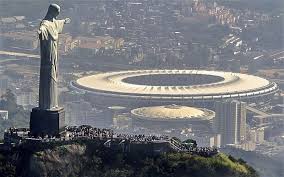By David Owen
June 15 – The Maracanã, along with Wembley probably the most famous stadium in world football, on Sunday hosts its first World Cup finals match for 64 years, when Lionel Messi’s Argentina take on tournament debutants Bosnia & Herzegovina.
Today capacity at the redeveloped venue is below 77,000, but on 16 July 1950 not far off 200,000 people are estimated to have crammed in there to witness the most devastating defeat in Brazil’s football history, a 2-1 reverse that handed the first World Cup on Brazilian soil to Uruguay. This has become known as the Maracanazo – a word that a Brazilian victory in the 2014 FIFA World Cup could finally expunge from the national vocabulary.
According to the Brazilian Sports Confederation (CBD)’s official report of that 1950 tournament, unearthed for me by FIFA, construction of the vast amphitheatre began in August 1948 and it was inaugurated by Brazilian President Eurico Gaspar Dutra, a military man from Cuiabá, with a symbolic ribbon-cutting, on 17 June 1950. A week later Brazil hammered Mexico 4-0 in the tournament’s opening match.
Construction of the arena was said to have been “technically…one of the most important that has ever been executed in Brazil” up to that time. The project consumed 500,000 bags of cement, 50,000 cubic metres of sand, 12,000 tons of iron, 3 million bricks and 195,000 kilograms of nails.
Just as some of the 2014 World Cup venues have faced a race against time to be ready for their first World Cup matches, it seems that the finishing touches were put to the brand new Maracanã only after some of the competing teams had arrived in Brazil.
Charles Buchan, a former England international turned writer and journalist, described his visit to Brazil to report on England’s ill-fated first World Cup campaign, in an autobiography, A Lifetime in Football. On accompanying the England players to the stadium in the days leading up to their first match against Chile, Buchan reports that they were “amused by the moat that, with a high wire fence, separated the spectators from the field of play”.
He also wrote that “much work had still to be done to the stadium dressing rooms situated under the stands”. To reach the pitch, players had to “go along a concrete corridor and then climb twenty-three steps until they reached a heavy steel door. When this swung back, they emerged into the dazzling sunshine and saw the pale blue seats which circled the Stadium.” No wonder Uruguay seem to have felt at home there.
The official report discloses that 173,850 tickets were actually sold for the decisive all-South American clash, including 4,685 designated as military. Just over a million tickets were sold for the tournament all told, with one match between Switzerland and Mexico in Porto Alegre attracting just 3,580 spectators.
Contact the writer of this story at moc.l1745044557labto1745044557ofdlr1745044557owedi1745044557sni@n1745044557ewo.d1745044557ivad1745044557

